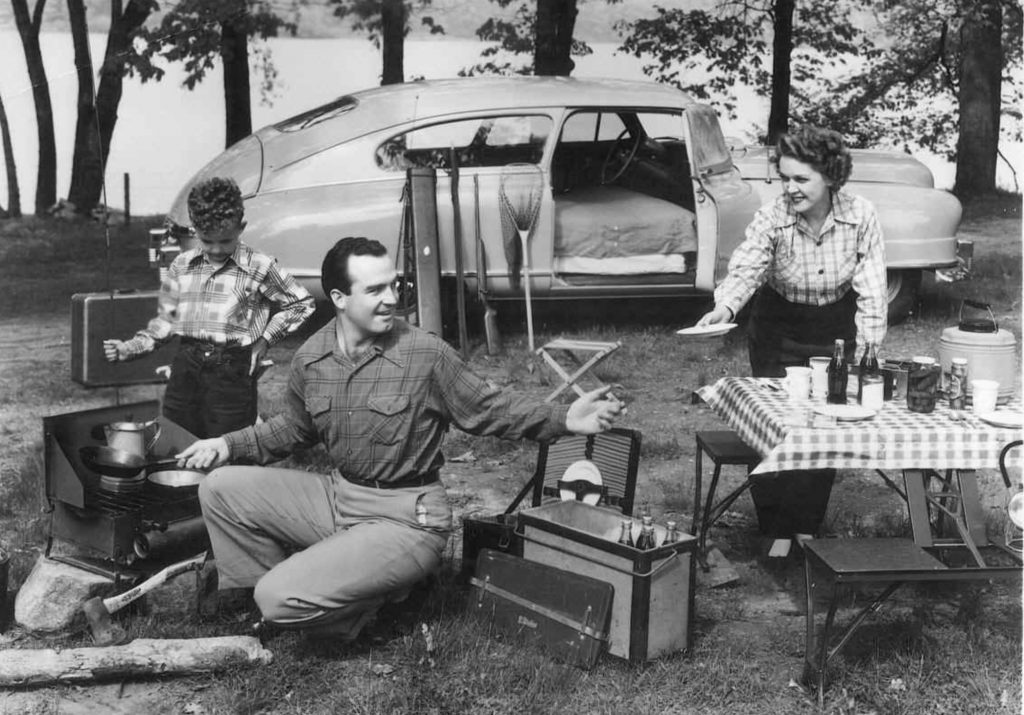
Since the automobile’s inception, auto manufacturers and suppliers have offered optional and aftermarket products to convert the automobile into mobile sleeping quarters. To address the needs and desires of a traveling public, Daniel Strohl notes, “carmakers have expressly made their vehicles suitable for camping”(hemmings.com). Such alterations and add-ons include folding front seats that provide a flat sleeping area, accessory tents for hatch back models, sleeper units for passenger vans, and a “magic camper package” for the ubiquitous minivan. These accessories allow folks to expand the automobile’s primary function as a mode of transportation into a more flexible vehicle that meets individual and family travel needs.
By offering these products and accessories, manufacturers have – over the years – reacted to the car-owning public’s desire to use the automobile in ways not originally intended. As noted by Kathleen Franz in Tinkering, “consumers became tinkerers and occasionally inventors as they outfitted their cars for travel […]” (second cover). Taking matters into one’s own hands, however, was not limited to men. During the early years of automobility, female owners and drivers actively reconfigured the automobile for their own use. As Franz writes, “women, who were portrayed by manufacturers and their husbands as passive consumers, remade themselves into competent mechanics and active users” (110.) Women who travelled alone often found it necessary to modify and outfit their cars to meet middle-class standards of domestic comfort and economy; in doing so they also challenged the common perception of women’s technological ability and ingenuity. Franz remarks, “women drivers tinkered with the car and, by extension, with their gender roles’” (42). Although advertising for automotive accessories during this time was directed toward the male consumer, women were, in fact, active participants in the tinkering phenomenon.
In a recent project, I interviewed women in their 80s and 90s about their early automotive experiences. Many of them recalled how when travelling with husbands or young children, they altered the automobile to meet family needs. Before chain hotels were commonplace, decent lodgings in out-of-the ways places were few and far between. One of the women described how she converted the family station wagon into cozy sleeping quarters with the addition of curtains and other amenities for a long distance trip. Others mentioned how – as primarily responsible for the children on family road trips – they devised ways to keep young passengers quiet, safe, and occupied. Whether laying down the car’s back seat to accommodate a baby’s playpen, converting the back seat of a VW Beetle into a bed for an infant, repurposing the back seats of a station wagon into a child’s play area, or using a husband’s leather belt to strap a young traveler onto the front seat “hump,” these women called upon imagination, innovation, and resourcefulness to make family road trips enjoyable for everyone.
Advertisements, marketing brochures, and news articles produced during the early to mid-twentieth century uniformly suggest that women’s role in auto travel was solely a domestic one. However, as noted in Franz’s work as well as my own, whether traveling on their own or with children in tow, women were also instrumental in reconfiguring and accessorizing the automobile into a comfy home on wheels for all of its passengers.
Franz, Kathleen. Tinkering: Consumers Reinvent the Early Automobile. Philadelphia: University of Pennsylvania Press, 2005.
Lezotte, Chris. “Born to Drive: Elderly Women’s Recollections of Early Automotive Experiences” The Journal of Transport History 40.3 (2019): 395-417.
Stohl, David. “Well Before Hashtag Vanlife, Carmakers Encouraged You to Sleep in Their Cars” Hemmings.com 10 Dec 2019.
Do you have memories of family road trips? How was your car reconfigured to accommodate a sleeping family? Feel free to tell your travel stories.